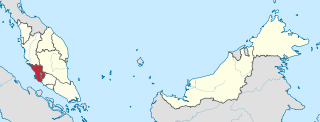
Kuala Lumpur, officially the Federal Territory of Kuala Lumpur and colloquially referred to as KL, is a federal territory and the capital city of Malaysia. It is the largest city in Malaysia, covering an area of 243 km2 (94 sq mi) with an estimated population of 1.73 million as of 2016. Greater Kuala Lumpur, also known as the Klang Valley, is an urban agglomeration of 7.564 million people as of 2018. It is among the fastest growing metropolitan regions in Southeast Asia, both in population and economic development.

Selangor, also known by its Arabic honorific Darul Ehsan, or "Abode of Sincerity", is one of the 13 states of Malaysia. It is on the west coast of Peninsular Malaysia and is bordered by Perak to the north, Pahang to the east, Negeri Sembilan to the south and the Strait of Malacca to the west. Selangor surrounds the federal territories of Kuala Lumpur and Putrajaya, both of which were previously part of it.

The Sultan Abdul Samad Building is a late-nineteenth century building located along Jalan Raja in front of the Dataran Merdeka and the Royal Selangor Club in Kuala Lumpur, Malaysia. The building originally housed the offices of the British colonial administration, and was known simply as Government Offices in its early years. In 1974 it was renamed after Sultan Abdul Samad, the reigning sultan of Selangor at the time when construction began.
The Royal Selangor Club is a social club in Kuala Lumpur, Malaysia, founded in 1884 by the British who ruled Malaya. The club is situated next to the Dataran Merdeka, or Independence Square, padang (field), and is accessible from Jalan Raja. The Club will play host to certain matches from the ICC U-19 Cricket World Cup.

Brickfields is a neighbourhood located on the western flank central Kuala Lumpur, Malaysia. It is known as Kuala Lumpur's Little India due to the high percentage of Indian residents and businesses. Brickfields been ranked third in Airbnb's list of top trending destinations.
Malaysian National Projects are major national and giant projects which are important in the development of Malaysia.

The Klang War or Selangor Civil War was a series of conflicts that lasted from 1867 to 1874 in the Malay state of Selangor in the Malay Peninsula.

Sultan Abdul Samad ibni Almarhum Raja Abdullah was the fourth Sultan of Selangor.

Sultan of Selangor is the title of the constitutional ruler of Selangor, Malaysia who is the head of state and head of the Islamic religion in Selangor. The current monarch, Sultan Sharafuddin Idris Shah ascended the throne on the death of his father, on 22 November 2001.

This article lists important figures and events in Malaysian public affairs during the year 1990, together with births and deaths of notable Malaysians.
Transportation in the Klang Valley, which includes Kuala Lumpur – the capital city of Malaysia – consists of highly-developed intermodal infrastructure. This includes an extensive road network, an integrated railway network, airports, and other modes of public transport. The Klang Valley is an urban conglomeration consisting of the city of Kuala Lumpur, as well as surrounding towns and cities in the state of Selangor. The Klang Valley has the country's largest airport, the Kuala Lumpur International Airport (KLIA), as well as the country's largest intermodal transport hub and railway station, Kuala Lumpur Sentral.

Kuala Lumpur is the largest city in Malaysia; it is also the nation's capital. The history of Kuala Lumpur began in the middle of the 19th century with the rise of the tin mining industry, and boomed in the early 20th century with the development of rubber plantations in Selangor. It became the capital of Selangor, later the Federated Malay States, and then Malayan Union, and finally Malaya and Malaysia.
The architecture of Kuala Lumpur is a blend of old colonial influences, Asian traditions, Malay Islamic inspirations, modern and post modern mix. Being a relatively young city, most of Kuala Lumpur's colonial buildings were built toward the end of 19th and early 20th century. These buildings have Mughal, Tudor, Neo-Gothic or Grecian-Spanish style or architecture. Most of the styling have been modified to cater to use local resources and the acclimatized to the local climate, which is hot and humid all year around.
Jalan Damansara is a major road in Kuala Lumpur, Malaysia. One of the oldest roads in the city, it currently serves as a link between the Damansara sections of Petaling Jaya and Kuala Lumpur.

Arthur Benison Hubback was an English architect and soldier who designed several important buildings in British Malaya, in both Indo-Saracenic architecture and European "Wrenaissance" styles. Major works credited to him include Kuala Lumpur railway station, Ubudiah Mosque, Jamek Mosque, National Textile Museum, Panggung Bandaraya DBKL, Ipoh railway station, and Kowloon railway station.
Arthur Charles Alfred Norman (1858-1944), often referred to as A. C. Norman, was a British architect who was active in Malaya at the end of the 19th century and the beginning of 20th century. Some of the most important colonial era buildings of Kuala Lumpur built in that period were credited to him, although many of these also involved other architects of the period.

Bukit Bintang is a Monorail station located in Bukit Bintang, Kuala Lumpur. As part of the KL Monorail line, it opened alongside the rest of the train service on August 31, 2003.

Jamek Mosque, officially Sultan Abdul Samad Jamek Mosque is one of the oldest mosques in Kuala Lumpur, Malaysia. It is located at the confluence of the Klang and Gombak River and may be accessed via Jalan Tun Perak. The mosque was designed by Arthur Benison Hubback, and built in 1909.
The following is an alphabetical list of articles related to Selangor.


















